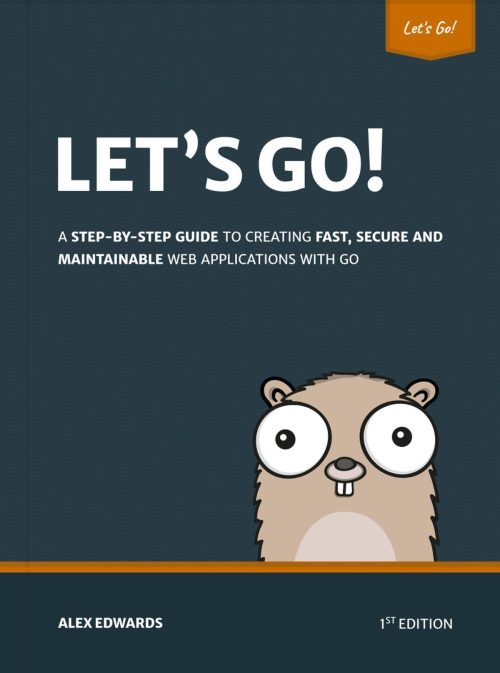Let’s Go is a clear, concise, and easy-to-follow guide to web development with Go.
It contains everything you need to know about best practices, project structures, and practical code patterns without leaving out important details and explanations.
Go is a great language for building web applications. But educating yourself from blog posts and standard library materials can consume a lot of time and leave you with more questions than answers.
You may be wondering things like:
✓ Where can I see concrete examples of real-world web applications?
✓ What is the best way to structure and organize my code?
✓ How do I manage and version control dependencies?
✓ And how do I test my web application effectively?
Let’s Go will answer these questions for you, and many more, getting you up to speed quickly and saving you months of research and testing.
The book walks through the process of building a fully working application from start to finish, helping you learn by doing. You’ll get hands-on experience implementing common real-life code patterns, the topics you’re learning will be put in context, and you’ll get a well-structured code base that you can use. Adjust for your own future work.
By the end of the book, you’ll have all the knowledge and confidence you need to build your own professional, production-ready web applications.
What you will learn:
✓ 1. All platforms – How to start a server, create handlers, send responses, route requests and serve static files.
✓ 2. Structure and organization – How to create an idiomatic and scalable structure for your web application.
✓ 3. Using modules – How to use Go’s Module functionality to manage and version control your dependencies.
✓ 4. Configuration Management – How to use command-line flags and dependency injection to manage your application settings.
✓ 5. Logging and error handling – How to implement level logging and centralized error handling.
✓ 6. SQL database – How to design a database model, set up a connection pool, and execute commands and queries.
✓ 7. HTML templating – How to cache your templates, display dynamic data, create custom functions, and handle runtime errors.
✓ 8. Middleware – How to create your own middleware to perform common actions (like logging requests and recovering panics).
✓ 9. RESTful routing – How to create a modern request routing structure that follows REST principles.
✓ 10. Form validation – How to implement a reusable and user-friendly pattern for form validation and error display.
✓ 11. Session management – How to use and configure sessions to maintain data between requests.
✓ 12. Using HTTPS – How to correctly set up an HTTPS server and configure it for improved performance and security.
✓ 13. Embedding files – How to embed static content (like HTML templates, images, CSS and JS files) into your Go binary.
✓ 14. Prevent common vulnerabilities – How to prevent SQL injection, CSRF, XSS, clickjacking and slow-client attacks.
✓ 15. Authentication and authorization – How to securely encrypt user passwords and add registration, login and logout functionality.
✓ 16. Request context – How to use Go’s context.Context to pass data between middleware and your handlers.
✓ 17. Testing – How to create unit tests, integration tests and end-to-end tests, mock dependencies and measure test coverage.
✓ 18. And most importantly… How to put it together in a fully functional app!
Link download : https://drive.google.com/drive/folders/1C5bRxMteaTZ-_CxH-CcoIvxLgvMjvOQp
Password open file : https://drive.google.com/drive/folders/1lna5LnxuP3DTN6hx-cMYuYdzNboyIhIB

